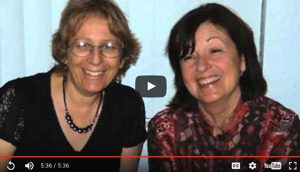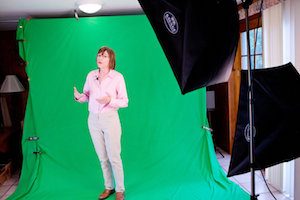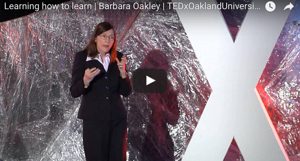In this message, I wish to share with you two teaching narratives I have encountered recently as a way of advancing our professional development program’s goal of re-centering at least some of our conversations around teaching and learning.
A Humanities Narrative
Our new VP for Instruction, Diane Diekmeyer, shared with me some digital stories about faculty from her previous college. This one features Sharon Crasnow, a Norco College philosophy professor.
I share Professor Crasnow’s story because it explores the link between why someone teaches and how someone teaches. Crasnow intrigues me because she is motivated both by her own learning experiences as a child / student and by a transformative experience she has later in her teaching career when she felt burnt out, stuck in a bit of a slump. Hers is not the intimidating story of a master teacher marching triumphantly through the world of higher education but a narrative of a “mere” mortal negotiating the challenges and joys of teaching and learning over the course of a career as an educator.
Check out Professor Clasnow’s story, if you have time. Consider responding, either to this email or on our Joyful Teaching blog.
Of course, you can always go for the informal chat with a colleague option too!
A STEM Narrative
You may also want to check out a recent story in the New York Times about Barbara Oakley, an engineering professor at Oakland College in Michigan, whose “Learning to Learn” course has become the most popular course in Coursera’s history (over 1.8 million students have taken the course). Here is here TEDx talk, which discusses her personal journey and how it relates to the research and teaching she has done about learning strategies across the disciplines. Like Crasnow, Oakley grounds her passion for her work in both her own experiences as a learner and her ongoing professional explorations and discoveries.
While you may or may not agree with how Professor Crasnow and/or Oakley approach teaching, I hope you will find that reading about what our colleagues are up to encourages you to think about the how and why of your own teaching (and maybe some of the great teachers you have met and worked with!).
As always, the time you spend exploring and discussing these resources is flex eligible.
Flex Week
Flex week offers you another way to explore your colleagues’ ideas about and approaches to teaching. Here is a list of teaching and learning centered offerings in our Fall 2017 flex week schedule. These workshops have the TL tag attached to them. (Note: I did not include canvas workshops here because I have highlighted those elsewhere).
Monday August 14
- Student Connections: Contextualized Learning
9-10 AM OC 3607 - Interactive Tools to Spice Up Your Class
9:30-11:00 AM OC 3606 - Service Learning 101: Linking Course with Community
11:30-1:00 PM Aztlan A and B - What I Wish I Had Known When I Started at MCC
12-1:30 PM OC 3606 (with a particular focus on the associate faculty experience) - Open Ed Resources & Zero Textbook Cost Materials
12-2 PM OC 4611 - Constructing Successful Honors Contracts
1:00-2:30 OC 3609
Tuesday August 15
- Developing an Associate Faculty Mentoring Program
9-11 AM OC 3501 - Fall 17 Update @ MCC Library
10-11 AM OC 1201 - Facilitating Successful Peer Review in Any Course
11-12 OC 3607 - Book Discussion Group
2 -4 PM OC 3606 - Constructing Successful Honors Contracts
2-3:30 OC 3609 - Four Activities to Promote Classroom Engagement
3-4:30 PM OC 3607 - Fall 17 Update @ MCC Library
3:30-4:30 SEC 107
Wednesday August 16
- Student Connections: Contextualized Learning
12-1 PM OC 3607 - But I’m Too Busy to Take a Sabbatical
12-1 PM OC 3609 - Reading and Writing (no ‘rithmatic)
12-1 OC 3504
Thursday August 17
- Reading Festival Author 17-18 Alex Montoya
10:30-12 Noon CLC 104 - CCC: Supporting ESL Students Across Disciplines
11-12:30 PM OC 3515 - Scholarscapes: MiraCosta Profs Share Big Ideas
11-1 PM OC 1068 Board Room - Using PhET Online Simulations in STEM Classes
1-2:30 PM OC 3609 - CCC: Understanding Chican@/Latin@ Students and the Structural and Relational Barriers to Their Success
2:30-4:30 PM OC 3515 - Noncredit Student Survey Results 2017
2-3 PM CLC 104



I just watched the Crasnow TedTalk and liked it very much. I teach an all-grammar-all-the-time course at another campus and find many points from the TedTalk to be quite poignant. Crasnow’s ideas about Focused vs Diffused thinking, for example, applies to many students who get lost in the tedium of parts of speech and the function of words in a sentence. They, therefore, fail to recognize what the sentence is communicating. That ability to read the message in the sentence would allow them to find more readily the who’s-doing-what (subject and verb) and the what-about-what (modifiers). I believe this fault is like being unable to, as the saying goes, see the forest for the trees. Crasnow gives permission to students to switch from a “focused” mode (seeing one word at a time) of thinking to that “diffused” mode that allows them to relax and see the meaning in the sentence. They are doing their analysis before they understand what they are analyzing. It’s like having a thousand Legos but no picture of what it is they are building.
Regarding the slow thinker, like Crasnow’s metaphor of the hiker who stops and sees every detail in nature, I believe the student who slows down thoughtfully and examines each part of the sentence trying to figure out how each part is functioning and how it connects to the rest of the sentence and its meaning, is the student who will retain the ability to craft a meaningful and syntactically sound, well-edited sentence, one that pleasures a reader 🙂 Many students, in their attempt to keep up with the material and with other students in the class, rush their analyses. I may be guilty of moving too quickly through curriculum, and I may think of that hiker when I am rushing through a lecture or an exercise.
Well, posting here was a little scary, but I am always up for a little humble pie (oh dear, there’s another cliche).
Dang. I realized after posting that the professor’s name is Barbara Oakley. My sincerest apologies for the mistake.